As someone intimately involved in poultry, I find it hard to admit when I discover
something I didn’t know about the poultry industry. But that’s exactly what happened several years ago when my eldest son decided to start his own backyard poultry flock as a 4-H project and someone suggested that he begin by ordering live chicks through the mail. I had experience hatching eggs in an incubator and had enjoyed picking out a few young poultry during annual “chick days” at our local farm supply store, but mail-order chicks…that was news to me!
After a bit of research however, I quickly found out that not only are there dozens of top-
quality hatcheries willing to ship chicks (and many other species of young poultry) through the U.S. Postal Service, but hatcheries have been doing it for nearly a century! How can this be you ask? Well, this is a case where avian biology and human ingenuity comes together at its best. You see, just before hatching, chicks and other poultry absorb the last of the yolk inside the egg (their food source during incubation). This last bit of yolk provides the chick with enough nutrition to survive for 3-4 days with no outside source of food or water. Nature provides this period so that chicks that are the first in a hen’s clutch of eggs to hatch can survive until all the chicks have hatched when the hen takes her new brood out of the nest to feed for the first time.
Early poultry industry pioneers realized that this 3-4 day period of time could be used to
carefully ship chicks all over the U.S. using the postal service. As a matter of fact, the ability of chicks to thrive without food and water the first few days of their lives through the U.S. postal mail delivery system is one of the factors cited for the growth of the fledging U.S. poultry industry in the early 1900’s.
In 1910 an amateur poultry fancier could look through a hatchery catalog, fill out and
mail in an order form, and wait for live chicks to arrive at the local post office. In 2010, you can do the same thing with an internet connection and a few clicks of a mouse. As an example, simply typing “hatchery” into your favorite internet search engine will give you links to dozens of commercial hatcheries that offer mail-order delivery of chicks and other poultry.
Of course, while ordering chicks through the mail can be simple, there are some important
items to keep in mind:
1. Most hatcheries offer a choice of all females (pullets), all males (cockerels), or “straight
run” (a natural mix of females and males at hatching). Sexing of young birds is both
difficult (requiring special training) and is never 100% accurate, so single gender orders
are more expensive and not always completely single-gendered;
2. There will be a minimum number of chicks that must be ordered. This is important since
the body heat generated by the chicks in the travel container will reduce stress. However,
most hatcheries allow you to order different species and breeds in a single order;
3. When placing your order, check the shipping options (many hatcheries offer different
levels). Although most chicks will thrive well through the normal delivery time, paying a
premium for express delivery will reduce stress on young poultry; and
4. Check to see that the hatchery you select participates in the National Poultry
Improvement Program (NPIP). This program helps insure that birds are healthy and
prevents the spread of disease that might affect the health of your flock and other flocks
in your area.
Preparing to receive a shipment of live poultry takes some planning. Here are some tips:
1. Prepare a Brooder – By definition a brooder is simply a heated enclosure used to raise
fowl – and a brooder can be as simple a cardboard box with a metal hooded light
containing a 40-60 watt bulb. The enclosure needs to be small enough to maintain a
localized temperature between 90 – 95o F below the heat source, yet large enough to
contain a food and water source for the young chicks and allow ample room for
movement. While many commercial brooders are designed to maintain a constant
temperature throughout the entire brooder, a brooder set up with a localized heat source
usually works best for the backyard flock owner since this provides the brooder with a
range of temperatures that allows chicks to move to an area within their comfort zone. As
the picture below shows, my son made use of an empty watering trough.
2. Alert your Post Office – Although the U.S. Postal Service has been transporting live
chicks for over 100 years, receiving a box of cheeping chicks is still an unusual event.
Take the time to call your local post office and not only tell them about the shipment, but
also leave a phone number where you can be easily reached so that you can pick up your
chicks directly from the post office when they arrive.
3. Check your Shipment – Commercial hatcheries use a variety of shipment containers. As
the picture below shows, my son’s chicks arrived at our local post office in a small
cardboard container. Open the container at the post office and check on your chicks.
Don’t forget that these are animals and even under the best conditions you can expect
about 5% mortality within the first week. Many hatcheries include additional chicks in
orders to account for this loss. Also, many hatcheries insure their shipments with the post
office, but you need to know the condition of your shipment while still at the post office
in case of any issues.





























